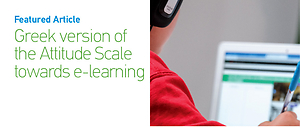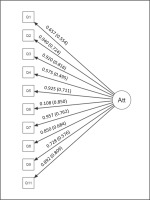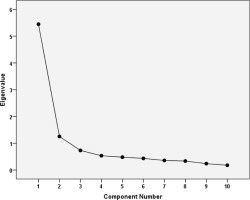INTRODUCTION
The issue of coronavirus disease has received significant criticism since January 20201. It is an additional threat to public health worldwide. It is reported that the pandemic led to unprecedented measures and one of their consequences was distance education. As a result, many countries, including Greece, were obligated to apply exclusively distance education in their educational system, in order to minimize the spread of COVID-19.
Due to the COVID-19 pandemic, a new digital educational reality emerged, and, as a result, the academic community is facing a number of challenges. In particular, the digital divide presented in world literature needs to be bridged2. Despite the difficulties, distance education offers students the opportunity to become acquainted with new technology as an urgent need. It is worth noting that distance education offers the students the opportunity to have employment at the same time as their studies or to be able to attend a second study program, if they wish3,4. Similarly, another positive aspect is the prospect of flexibility not only in space and time but also in many interdisciplinary fields based on their interests5,6.
In particular, international literature reveals that nursing students have largely adapted to restrictive measures of self-protection to limit the spread of the COVID-19 pandemic7. However, students seem to face some difficulties, particularly in clinical practice and this fact raises many concerns about their future progress8. In addition, there is evidence that shows a strong positive correlation between the stress of nursing students and their willingness to participate in the educational process9. Furthermore, a recent study in Uganda on a sample of nursing and medical students highlighted a lack of skills in using e-learning platforms10. Similarly, in a study conducted in India, a high percentage of nursing students do not believe that e-learning could replace face-to-face education11. In contrast, researchers in Croatia showed that the majority of nursing students preferred a mixed model based on a combination of face-to-face and distance learning12,13.
A questionnaire already developed through theoretical research by experts in the Philippines was used. The questionnaire included 111 Filipino nursing students at selected public and private universities. Varimax rotation and internal consistency reliability were used using Cronbach α and element total correlation. The scale was loaded into a component with loading rates ranging from -0.907 to 0.893, explaining 61.92% of the total variance. The KMO test revealed a value of 0.900, while the Bartlett test gave a value of 644.380 (df=55, p=0.000), the Cronbach alpha coefficient of the 9-item scale was 0.917. The tool was considered valid and reliable. The present study reports the translation, cultural adaptation and validation of the measurement of the attitude of nursing students regarding the sudden implementation of distance education in Greece during the pandemic. The translation strategy for intercultural research was used to translate the questionnaire into Greek. The aim of the study was the translation into Greek language, cultural adaptation and validation of the Attitude Scale towards e-learning during the period of the COVID-19 pandemic.
Even though there are studies that recognize the gaps and difficulties of the abrupt implementation of distance education14, there is a lack of knowledge concerning measuring the attitude of nursing students regarding the sudden implementation of distance education in Greece.
METHODS
Design and participants
A quantitative study was conducted to assess the attitudes of nursing students towards the sudden conversion of distance education during the COVID-19 pandemic.
A convenience sample of 341 nursing students who were attending online courses was collected from December 2020 to January 2021 in two Nursing Departments. Students were invited to participate in the study following an invitation from their lecturers. In addition, the questionnaire was distributed by an online form (LimeSurvey®) and, for this reason, the personal data of the students were not recorded. Students could leave the investigation process without any commitment. All participants entering the study provided written informed consent after receiving a complete description of the study and any of their questions answered. Along with the questionnaires, a cover letter explaining the purpose of the study was offered, providing the researchers’ affiliation and contact information, and clearly stating that answers would be confidential, and anonymity would be guaranteed in the final data reports.
Procedure
The questionnaire comprised 21 items, with a mean duration 5–8 min to complete.
The first part of the questionnaire included questions about demographic characteristics, habitation, contact with people belonging to high-risk groups during the pandemic period, the work factor during the same period, and previous experience with distance education.
The second part of the tool included the ATel15 which was used to measure attitudes towards distance education (after obtaining license for use and translation of the tool from the original developers). ATel scale comprised eleven items rated on a 5-point Likert-type scale (1=strongly disagree to 5=strongly agree). The internal consistency for the Greek version of the ATel was excellent (Cronbach’s alpha=0.90).
Translation and validation process
The original version of the questionnaire was translated into Greek using the back-translation strategy for cross-cultural research. Two experienced bilingual translators performed a forward translation independently, using the original English version (step I). Both forward versions were then conciliated and incorporated into the Greek version by an expert panel (step II), using a consensus procedure. The expert panel consisted of two professors of nursing, two nursing students, a psychologist, and an expert in psychometrics. The expert panel checked all items and inserted their recommendations into the questionnaire. Back translation was carried out by an English teacher who understood the Greek language, but had no knowledge of the questionnaire or access to the original version in English (step III). The semi-final version was derived from a reconciliation of the original, back and forward translations. As this was in agreement with the English original version, the translation was considered to be correct (step IV).
In this study, not only were the results formulated according to the Greek culture but also ensured the quality of the translation of the questionnaire from the original version. There are changes that could be made to a questionnaire due to the different culture of the country in which it is applied. It is worth noting that the demographic characteristics for the adaptation and validation of the questionnaire in the Greek language have been investigated, although the Philippine experts did not test them in the original version. The reason for this further investigation was the different culture that exists between these two countries.
Statistical analysis
Categorical variables (discrete and qualitative) were expressed as frequencies and percentages while continuous variables were expressed as means with standard deviation (SD). Kolmogorov-Smirnov test was applied for testing the data normality. Cronbach’s alpha was applied for measuring internal consistency of data. Independent samples t-test or the corresponding non-parametric Mann-Whitney test was applied for comparing means or distributions between continuous variables divided into two groups. More than two-group comparisons in continuous variables were performed using one-way ANOVA or the non-parametric Kruskal-Wallis test. Pearson’s or Spearman’s rho coefficient were used to examine the correlation of continuous variables.
Confirmatory Factor Analysis (CFA) was applied to confirm and validate the developer’s questionnaire structure. RMSA and CFI were used as measures of goodness-of-fit. Additionally, a principal components analysis (PCA) was run on an 11-items questionnaire and a Varimax rotation was used. Eigenvalues and frequencies total explained variance were estimated to identify the number of components in the EBP questionnaire. The overall Kaiser-Meyer-Olkin (KMO) measure and Bartlett’s test of sphericity were applied for testing the appropriateness for a PCA.
Statistical analysis of data was performed in an IBM SPSS Statistics 26.0 software and a level of significance was set to p=0.05.
RESULTS
From a total of 399 records in the online LimeSurvey®, 58 (14.5%) were excluded due to incomplete data.
Demographic characteristics of the participants are presented in Table 1. There were 294 (86.2%) women, and the mean age of the participants was 24.4±8.1 years. Most (303; 88.9%) of the students were single, 224 (65.7%) were living with their family, while 25 (7.3%) students had a roommate and 110 (32.3%) were living with high-risk people (e.g. old, chronic diseases). Regarding e-learning process, only 43 (12.6%) students had previous experience, and 39 (11.4%) reported a learning deficit issue (Table 1). Figure 1S (Supplementary file) summarizes the total number of filled in questionnaire items, while Table 1S (Supplementary file) shows that there is no selection bias between filled in and excluded questionnaires in terms of sex, university, and study period.
Table 1
Sociodemographic characteristics of the participants
Initial CFA results are given in Table 2S (Supplementary file). One of the 11 items (‘E-learning environment needs advanced technical knowledge on computer use’) does not converge with the one factor solution as proposed from the questionnaire development (p=0.450). When this item was excluded from the questionnaire, the path diagram showing the converge is shown in Figure 1. Beta coefficient ranged 0.575–1.108. Goodness-of-fit seems moderate, since RMSEA value is 0.131 (best fit when RMSEA is <0.09) and CFI is 0.877 (fit limit >0.90). In addition, EFA was applied in 11-items questionnaire and the same deleted item showed an almost zero loading (-0.007) (Supplementary file Table 3S).
Validity and reliability indices
In Table 2 and Figure 2, PCA was presented in the 10-item questionnaire. Analysis resulted in one explanatory factor. Presented eigenvalues were for the 5.446%, while the cumulative explained variance was 54.462%. KMO (KaiserMeier-Olkin) value was 0.910 and the Barlett’s test of sphericity gave χ2=1031.74, df=45 and p<0.0001, supporting the use of PCA on the ATel 10-items questionnaire.
Table 2
Exploratory factor analysis of the total variance explained by factor eigenvalues
| Initial (non-rotated) | |||
|---|---|---|---|
| 1-factor solution | Total | Variance % | Cumulative % |
| 1 | 5.446 | 54.462 | 54.462 |
The ATel does not follow a normal distribution as shown from the K-S test (p<0.001). The 10 items of the Greek version of the ATel (ATel-GR) showed a high level of internal consistency with a Cronbach α equal to 0.905 (Table 3). Supplementary file Table 4S presents the values for Cronbach’s α and their values if item was deleted.
Table 3
Statistical indicators of the attitude towards e-learning scale
| Items | Cronbach’s α | Mean±SD | Kurtosis | Skewness | p* | |
|---|---|---|---|---|---|---|
| Attitude | 10 | 0.905 | 2.80±0.94 | -0.307 | 0.424 | 0.001 |
Table 4 shows the factor loadings of ATel-GR. The 1-factor solution shows non-rotated loadings of each item. All items showed high loading >0.500.
Table 4
Factor loadings of ATel-GR
Age as a continuous variable showed a weak correlation with ATel (rs=0.254, p<0.001). When age was treated as an ordinal category variable (age group: 20–23, 23–29, >29 years), a positive linear trend was observed with Attitude Scale. Mean age values were 2.65±0.91 for <23 years, 3.06±0.95 for 23–29, and 3.15±0.96 for >29 years. Gender does not affect any of the scales (p=0.921), while those who were married had a statistically significant higher mean (3.24±0.80) than those who were single (2.74±0.95) in Attitude Scale (p=0.000). Living in a student residence or living with a roommate showed the minimum (2.32±0.75) and the maximum (3.25±0.89) Attitude Scale score, respectively (p=0.007).
In Attitude scale scores, the findings revealed a positive correlation between attitude and previous experience in e-learning. Mean score in participants with experience was 3.09±1.16 showing significant differences (p=0.32) from participants without experience (2.76±0.91) (Table 5).
Table 5
Differences between sociodemographics characteristics with attitude towards e-learning scale
| Characteristics | ATel* | |
|---|---|---|
| Mean±SD | p | |
| Age (years), rho | 0.174 | <0.001 |
| Age groups (years) | 0.000 | |
| 20–23 | 2.65±0.91 | |
| 23–29 | 3.06±0.95 | |
| >29 | 3.15±0.96 | |
| Sex | 0.893 | |
| Male | 2.78±1.06 | |
| Female | 3.00±0.93 | |
| Marital status | 0.000 | |
| Single | 2.74±0.95 | |
| Married | 3.24±0.80 | |
| Habitation | 0.007 | |
| Family | 2.84±0.97 | |
| Alone | 2.60±0.86 | |
| Roommate | 3.25±0.89 | |
| Student residence | 2.32±0.75 | |
| Living with people at high risk | 0.465 | |
| Yes | 2.87±1.03 | |
| No | 2.76±0.90 | |
| Learning deficit | 0.104 | |
| Yes | 3.09±1.16 | |
| No | 2.76±0.91 | |
| Previous experience in e-learning | 0.022 | |
| Yes | 3.13±1.05 | |
| No | 2.74±0.92 | |
DISCUSSION
The Greek version, ATel-GR, of the questionnaire ATel, which consists of 10 items, is user- friendly and easy to complete. The questionnaire focuses on measuring students’ attitudes towards the sudden and exclusive use of distance education due to the COVID-19 pandemic.
In this study, not only were the results formulated according to the Greek culture but also ensured the quality of the translation of the questionnaire from the original version15. Moreover, Guillasper et al.15 found that EFA revealed 9 items leading to one single factor. In our analysis, one factor was found with the difference that EFA appointed 10 items out of the 11 used (EBP attitude). According to the literature, changes can be present on a questionnaire because of the different culture of the country where it is applied16,17.
Standardized Cronbach’s alpha coefficients for the Greek questionnaire were found to be similar to those reported by Guillasper et al.15 in the first validation study. The Greek version of the questionnaire showed as strong internal reliability (Cronbach’s alpha 0.901) as the original version of the tool.
In the present study, an important finding was that the age seems to be a determining factor for the attitude of nursing students towards distance education. Specifically, the students of the age group 23–29 years (3.09±0.95) and >29 years (3.15±0.96) maintained a positive attitude towards the implementation of distance education as they considered that the flexibility could be a great advantage for them. Recent studies gave prominence to flexibility as a major advantage for working students of all ages that is offered by distance learning compared to face-to-face learning18-20. On the other hand, a recent study showed that the flexible nature of distance education compared to face-toface education burdens the mental health of nursing students as they felt anxious about their future progress21. Similarly, a study revealed the negative impact of the absence of social interaction among students and teachers because of distance learning as it was one of the restrictive measures that were established during the COVID-19 pandemic22,23.
In addition, the present study highlighted that the marital status of the participants influences the attitude of nursing students towards distance education. Specifically, married participants (3.243±0.80) held a more positive attitude towards distance education than unmarried ones (2.74±0.95). This important finding was supported by a recent study that showed the flexibility that distance education offers to students’ family responsibilities. It was an advantage for the students to utilize the distance education in the space and time they wanted. However, the same study brought to light some difficulties that were generated due to the sudden and exclusive application of distance education in the wider field of the family24. Furthermore, a recent study in Albania found that restrictive measures had a significant impact on depression levels of both students and their families during the period of COVID-19 pandemic25,26.
Further, the present study stresses the importance of prior experience in distance education for students’ attitudes. In particular, participants with previous experience (3.09±1.16) in comparison to participants with no previous experience (2.76±0.91) in distance education had a more positive attitude. According to a recent study, students with no previous experience (31%) had to face preferences in the sudden transition of distance education from face-to-face education due to the COVID-19 pandemic18. Similarly, a multicenter study conducted in three European countries revealed that 59.1% of participating nursing students’ mental health deteriorated due to the implementation of restrictive measures imposed during the COVID-19 pandemic, including the sudden implementation of distance education26.
As observed in the present study and in some other recent studies, nursing students held a positive attitude towards distance education7,15,27. It is noteworthy, that this questionnaire examined the attitude of nursing students towards the sudden implementation of distance education during the COVID-19 pandemic. This tool could be helpful in nursing education research in order to avoid the negative consequences of sudden future changes as that of the COVID-19 pandemic. On the other hand, this questionnaire would be useful for the science of Psychology as it can measure the negative emotions of students due to distance education as a result to abandon their daily habits. Finally, future research could study the remedy to weakness from the exclusive use of distance education during the pandemic.
Strengths and limitations
This was the first study to investigate the attitude of nursing students in distance education in Greece with the validation of a new tool that combines both the EFA (Exploratory Factor Analysis) and CFA (Confirmatory Factor Analysis) (structural equation modeling) approaches. In addition, no previous studies have been identified that translate and validate a useful tool for a sample of Greek nursing students. Finally, the present study included students, which emphasizes the careful management and evaluation of the translation of the questionnaire. Overall, further scientific research is needed to explore potential solutions for the smooth psychosocial adaptation of nursing students to the new digital education context.
CONCLUSIONS
The Greek version of the questionnaire appears to be a reliable and valid tool, being quick and easy to complete. This instrument may become a useful tool in future research investigating the attitude of nursing students towards e-learning and assessing their specific needs. It is evident that this study provides a modern handy tool bridging this knowledge gap and supplying an important resource for researchers who might use it with the aim of exploring this field in the future.




